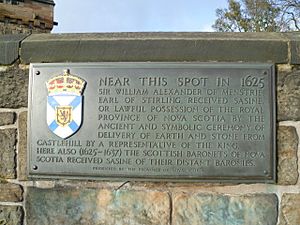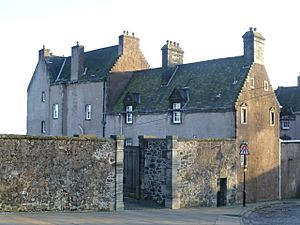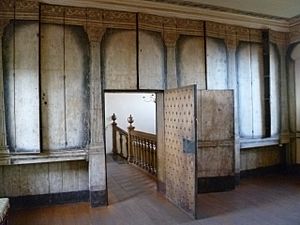Argyll's Lodging facts for kids
Argyll's Lodging is a beautiful old house from the 1600s. It's built in the Renaissance style, which was popular for art and buildings back then. You can find it in Stirling, Scotland, right below the famous Stirling Castle.
This house was once home to important people like William Alexander, 1st Earl of Stirling and later the Earls of Argyll. Experts say it's one of the most important old town-houses left in Scotland from that time. In the late 1900s, it became a museum where you can learn about its history.
Contents
History of Argyll's Lodging
Early Owners: Traill and Erskine
No one is completely sure who built the very first house that became Argyll's Lodging. It's located on Castle Wynd, the road leading up to Stirling Castle. People think a rich merchant named John Traill built the first part. It probably had two floors, with a main room upstairs and a kitchen downstairs.
In 1559, Traill sold the house to Adam Erskine. He was a church official who managed Cambuskenneth Abbey. Erskine made the house bigger, turning it into an L-shaped "tower house" with four floors. It had a small wing to the south and another to the west, where the kitchen was. In 1604, Erskine sold the house to a family member.
Sir William Alexander's Home
In 1629, Sir William Alexander bought the house from the Erskine family. His family was connected to the Campbells of Argyll, who owned other houses in Stirling. Sir William was able to buy the house because his wife, Janet Erskine, was related to the family.

Sir William was born in 1577 in Menstrie, a village near Stirling. He was a teacher to Prince Henry, who was next in line to the Scottish throne. When Scotland and England joined under one king in 1603, Sir William followed King James VI to London.
He became a knight in 1609 and was later made the main Secretary for Scotland for life. Today, he is best known for helping to start the colony of Nova Scotia in North America. This happened under a special permission from the king in 1621. In 1630, he became the 1st Earl of Stirling and Viscount Canada.
Sir William had his Stirling home redecorated when he heard that King Charles I was coming to Scotland. The king planned to have his Scottish coronation in 1633. Sir William made the house into a small palace with fancy rooms for guests and private areas. He also had the outside decorated beautifully.
He passed away in 1640, owing a lot of money. The town of Stirling took the house because of his unpaid debts. They wanted to use it as a guesthouse, but this never happened. In the 1660s, the house was sold to Archibald Campbell, 9th Earl of Argyll.
Above the main entrance, you can see Sir William Alexander's family crest. It shows a Native American and a mermaid holding up a shield. Above the shield is his family motto, Avt Spero Avt Sperno (meaning "Either I hope or I despise"). Below it is the motto for Nova Scotia, per mare per terras (meaning "by sea by land"). The crest is thought to be the first time a beaver was shown in a family crest.
The Campbells of Argyll
Archibald Campbell, 9th Earl of Argyll, born in 1629, was a strong supporter of the king. In 1666, he bought the house that would become known as Argyll's Lodging. He made it even bigger, adding parts to the north and south. He also built a wall with a grand entrance gate to enclose the courtyard. Inside, he had the walls decorated with paintings, some of which you can still see today.
In 1680, the Earl disagreed with a new law called the Test Act. This law made public officials promise loyalty to King Charles II. It also demanded they agree with the king's ideas about church and religion. Because the Earl refused to take this oath, he was declared a "traitor" in 1681. This meant he was accused of going against the king.
He was put in Edinburgh Castle, but he managed to escape by dressing as a woman. He then fled from Leith to the Netherlands. All his properties were taken away by the king.
However, the Earl had been smart. He had made a list of all his belongings in the Stirling house. He had also given them to his wife, Lady Anna Mackenzie. She was the daughter of the Earl of Seaforth, whom he married in 1670. Her first husband had been loyal to the king. Because of this, the king gave her money and let her keep her personal property.
In February 1685, Charles II passed away, and his brother James VII became king. Argyll returned to Scotland, planning to lead a rebellion against the new king. This was meant to happen at the same time as another revolt in England. In June, shortly after landing, Argyll was captured in Renfrew. He was taken to Edinburgh and executed in the town's Grassmarket.
The Campbell family owned the house for almost a hundred years after this. In 1746, during the Jacobite rebellion, Prince William, Duke of Cumberland stayed in the house.
From Hospital to Museum
In 1764, John Campbell, 4th Duke of Argyll, sold the house. Around 1800, the Army bought it to use as a military hospital. They needed more space than what was available in Stirling Castle. During the Napoleonic wars, the army grew a lot, and the small hospital in the castle was not big enough.
The house was used as a military hospital until 1964. After that, it became a youth hostel. In 1996, Historic Scotland opened it as a museum. They have decorated the rooms to look like they did in the past, using the detailed list made by the 9th Earl.
The Building's Design
Argyll's Lodging is located on Castle Wynd, the road that leads right up to Stirling Castle. It was built and decorated in the Renaissance style, which means it has grand and balanced designs. The house was originally shaped like the letter "P". The top part of the "P" had three wings around a courtyard on the west side. A wall with an entrance gate separated this courtyard from the street. The bottom part of the "P" was a southwest wing that also faced the street, but it was later taken down.
The north wing of the house had the kitchen on its ground floor. The eastern half of this wing was part of the original building with its first kitchen. The first floor of this wing held the private rooms. The main entrance, located in the central east wing, led directly into the Laigh Hall, which was a ground-floor cellar.
The first floor of the east wing had the High Dining Room, used for entertaining important guests. On the south side of this floor was the more private Drawing Room. The ground floor of the south wing contained rooms for the head of the household and his eldest son. The Lower Dining Room was in the southeastern corner of this wing. The first floor of the south wing held the bedrooms for the Lord and Lady of the house, and My Lady's Closet, which was the Lady's private sitting room.
Management
Argyll's Lodging is looked after and managed by Historic Scotland.







